
Gleditsia is a genus of trees in the family Fabaceae, subfamily Caesalpinioideae, native to the Americas and Asia. The Latin name commemorates Johann Gottlieb Gleditsch, director of the Berlin Botanical Garden, who died in 1786.

Catasetum, abbreviated as Ctsm. in horticultural trade, is a genus of showy epiphytic Orchids, family Orchidaceae, subfamily Epidendroideae, tribe Cymbidieae, subtribe Catasetinae, with 166 species, many of which are highly prized in horticulture.
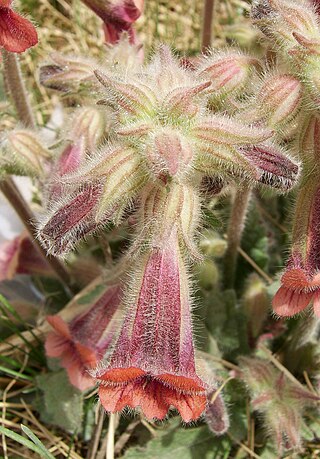
Rehmannia is a genus of seven species of flowering plants in the order Lamiales and family Orobanchaceae, endemic to China. It has been placed as the only member of the monotypic tribe Rehmannieae, but molecular phylogenetic studies suggest that it forms a clade with Triaenophora. Contrary to the immense majority of the taxa of Orobanchaceae, Rehmannia is not parasitic.

Double fertilization is a complex fertilization mechanism of flowering plants (angiosperms). This process involves the joining of a female gametophyte with two male gametes (sperm). It begins when a pollen grain adheres to the stigma of the carpel, the female reproductive structure of a flower. The pollen grain then takes in moisture and begins to germinate, forming a pollen tube that extends down toward the ovary through the style. The tip of the pollen tube then enters the ovary and penetrates through the micropyle opening in the ovule. The pollen tube proceeds to release the two sperm in the embryo sacs.
The Botanical Society of America (BSA) represents professional and amateur botanists, researchers, educators and students in over 80 countries of the world. It functions as a United States nonprofit 501(c)(3) membership society.
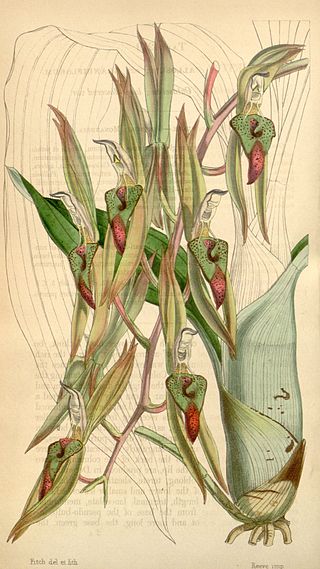
Catasetum callosum, the callused catasetum, is a species of orchid.
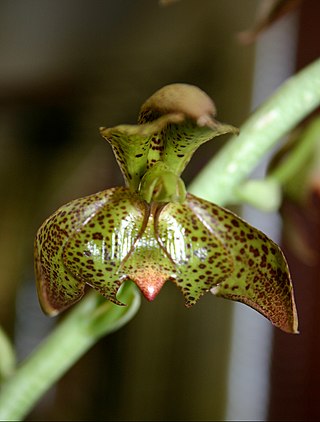
Catasetum cernuum, the nodding catasetum, is a species of orchid found from Trinidad to Brazil.
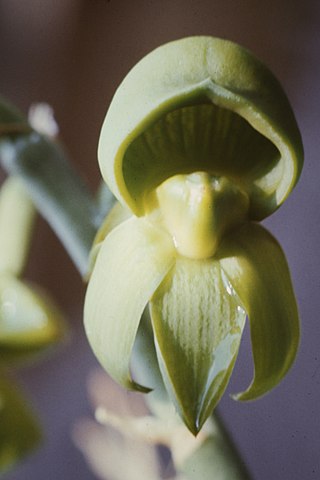
Catasetum discolor, the differently colored catasetum, is a species of orchid.
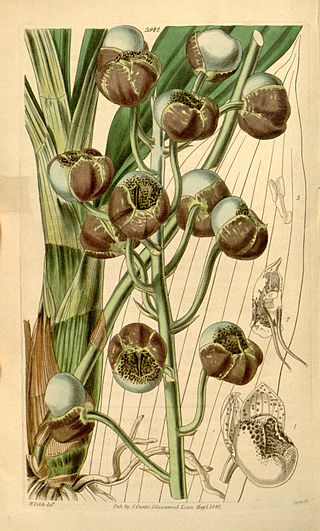
Catasetum globiflorum, the spheroid-flowered catasetum, is a species of orchid found in Brazil.
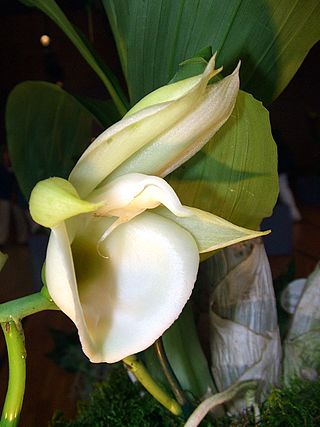
Catasetum pileatum, the felt-capped catasetum or mother of pearl flower, is a species of orchid found from Trinidad to Ecuador.

Catasetum saccatum, the sack-shaped catasetum, is a species of orchid.

Susanne Sabine Renner is a German botanist. Until October 2020, she was a professor of biology at the Ludwig Maximilian University of Munich as well as director of the Botanische Staatssammlung München and the Botanischer Garten München-Nymphenburg. Since January 2021, she lives in Saint Louis, where she is an Honorary Professor of Biology at Washington University and a Research Associate at the Missouri Botanical Garden.

Archaeopteris macilenta is distinguished from other species of the genus by leaves which are divided into narrow segments at their tips. Sporangia were borne on different parts of the branches with ordinary foliage leaves. Archaeopteris macilenta leaves and fertile shoots are attached to wood which when permineralized is called Callixylon newberryi. Archaeopteris is retained in the class Progymnospermopsida which includes plants with gymnospermous anatomy and pteridophytic reproduction.
The floral axis is the area of the flower upon which the reproductive organs and other ancillary organs are attached. It is also the point at the center of a floral diagram. Many flowers in division Angiosperma appear on floral axes. The floral axis can differ in form depending on the type of plant. For example, monocotyledons have a weakly developed floral axis compared to dicotyledons, and will therefore rarely possess a floral disc, which is common among dicotyledons.
Natalie Whitford Uhl (1919–2017) was an American botanist who specialised in palms.
Hanne N. Rasmussen is a Danish scientist who studies orchid-fungal symbioses.
Raymond Carl Jackson was an American botanist, known as Ray Jackson, noted "for his work in cytogenetics, particularly on polyploidy, and for his discovery of low chromosome numbers in angiosperms."
John Cameron Semple is a botanist, cytotaxonomist, professor emeritus, and adjunct professor at the University of Waterloo in Ontario, Canada. He was born in Boston and earned a degree of Bachelor of Science in 1969 from Tufts University, followed in 1971 and 1972 by Master of Arts and Doctor of Philosophy degrees from Washington University in St. Louis. Semple is known for his work with members of the tribe Astereae, particularly goldenrods, American asters, and goldenasters, and he maintains the University of Waterloo Astereae Lab website. Semple's wife is Brenda, and in 2013, he named a newly discovered goldenrod species Solidago brendiae in honor of her.
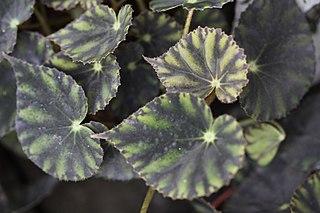
Begonia mazae is a species of flowering plant in the family Begoniaceae, native to southeastern Mexico. In its tropical forest habitat it grows in extremely dense shade.
Ann Kiku Sakai is a plant biologist at the University of California, Irvine known for her work on plant breeding and speciation. She is an elected fellow of the American Association for the Advancement of Science.












